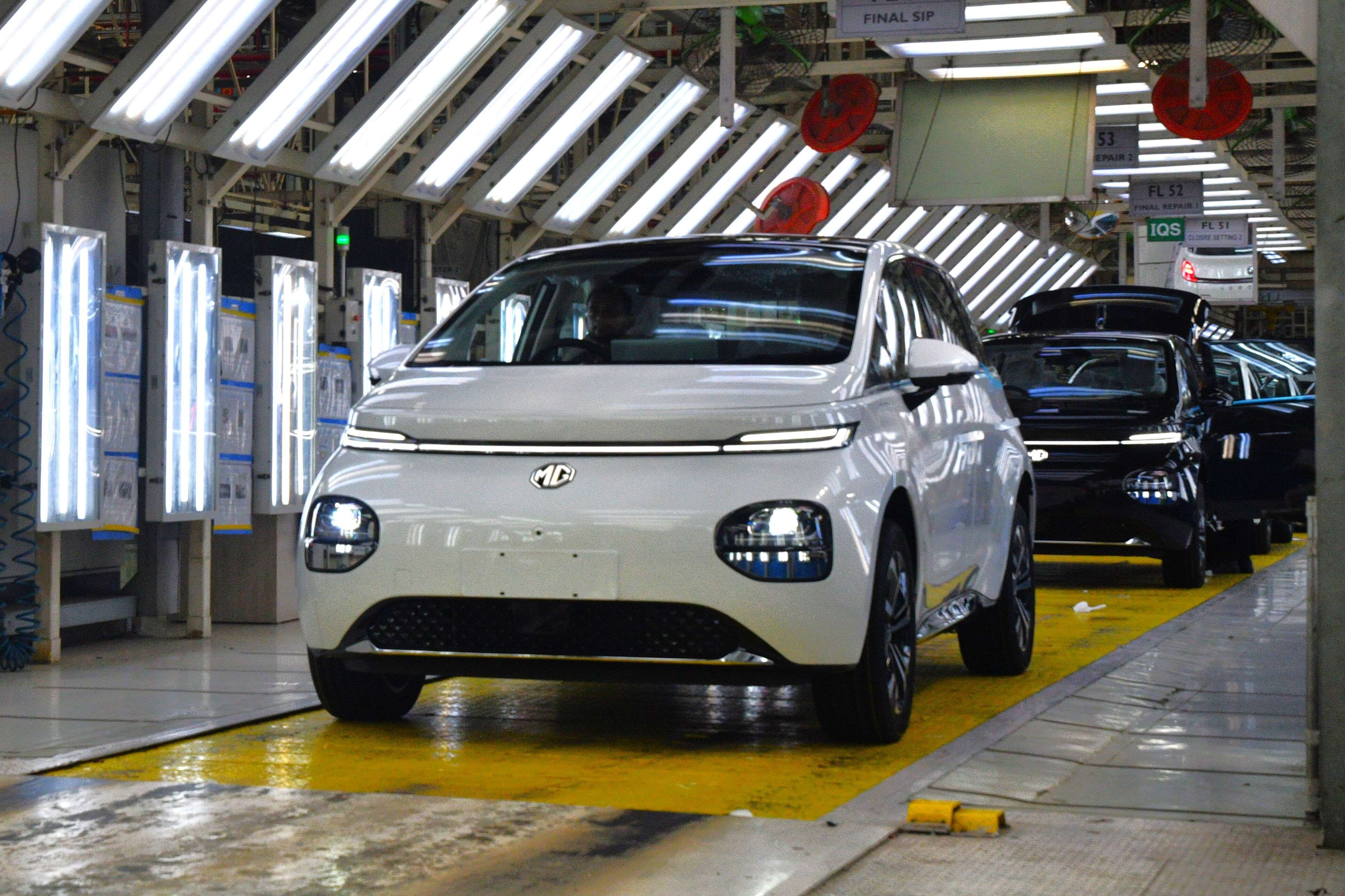
MG Motor India has been on a bit of a roll when it comes to EVs. As it stands, MG has eight models on sale here, and five of them are all-electric. The Windsor has particularly been a major sales success for the carmaker, with it crossing 20,000 unit sales in just six months and being crowned the fastest-selling EV in India to date.
Success like this would compel any carmaker to lean harder into the winning strategy, and MG has done the same. Last year, MG opened its first EV battery assembly shop within the premises of its Halol plant in Gujarat. Here, the battery packs for the MG Comet (17.3kWh) and Windsor Pro (52.9kWh) are put together, and we got to take a look at the process from soup to nuts.
Cellular adhesion
A battery pack is effectively a cluster of individual cells firing off electrons in harmony, so it only makes sense that the process begins with them. At the start point of the MG assembly line lay a pallet full of imported LFP cells, which are tested one at a time to ensure that they’re outputting the correct voltage and insulation resistance. The Comet’s battery pack has 36 cells, while the Windsor Pro’s 52.9kWh unit has 98 of them!
Once the cells pass validation, technicians apply insulating foam all around them to ensure temperatures remain stable in operation. The cells are then arranged in the most space-optimal way; the Windsor Pro’s battery pack features four rows of 17 cells each, sandwiched between two 15-cell rows.
This throng of cells will go into a huge metal tray that’s one half of the battery pack’s cover. Between the cells and metal tray lie wide strips of insulating foam, as well as the battery’s closed-loop cooling system. The latter comprises six rows of flat pipes through which coolant courses. A few rivets later, the basic underpinnings of the battery pack are affixed to each other.
The aluminium connection
After a quick 40sec test, a huge stencil is placed over the battery pack, leaving space solely over the terminals of each cell. The technicians place small, flat pieces of aluminium dubbed ‘busbars’ onto every neighbouring terminal pair, effectively forming a circuit for electrons to race through.
Once 98 aluminium busbars have been dropped into their respective places, the battery is wheeled into a small room with a huge automated laser welding arm. The machine fires off beams of ultra-intense light over 196 weld spots – one for each terminal. Given that the weld areas measure around 18mm, laser welding is one of the most accurate ways to get the job done.
A pair of technicians will then test the weld strength by using a pry tool to ‘scoop’ the busbar’s edges upwards. Should any of the weld points come loose at this point, the battery pack is sent back into the laser welding room and the specific busbar is subjected to the strong beams again. Once everything is deemed copacetic, the technicians lightly hammer the scooped edges of the busbars back into shape.
It’s also at this point where a wiring harness is installed on top of the battery pack, along with orange safety indicators over areas where current flow is the highest. The harness has tiny nodes on it that must be welded in place, so the battery goes for a second round of laser welding. However, the weld area is extremely small this time around – about 1-2mm – so technicians have to manually operate the laser welders to ensure extreme precision.
Then, the battery pack joins a single-file line where peripheral equipment like gaskets, cables, charging ports, etc., are fitted to it. Towards the end of this line, the BMS (battery management system) module is also connected to the battery. As the name suggests, the BMS module is the brain of the battery pack and controls all of its operations, much like an ECU does for an engine. Another round of validation awaits at the end of this line, following which the battery pack heads to one of its most crucial tests.
Taking charge
The charge-and-discharge (C&D) test is the definitive challenge every battery pack must overcome to be deemed worthy of slotting into an EV’s floorpan. In this temperature-controlled room – around 22deg C for optimal charging efficiency – the battery is wired up to a sizeable simulation machine that discharges the cells to a flat 0 percent and then charges them back up to 55 percent.
Some of you may be pondering the specificity of charging the battery pack to 55 percent only, and the reason behind it is rather simple: safety. MG says that at 100 percent charge, the battery pack holds quite a lot of voltage, which can pose safety risks while it’s being transported within the Halol plant or stored for longer periods of time. Given that the full C&D process is 3.5 hours long, I also reckoned that charging the battery to 100 percent would take much longer and, therefore, impact the assembly shop’s output, which currently stands at roughly 140 battery packs a day.
Once the battery pack passes the C&D cycle, it’s wheeled out into the final area where technicians apply a waterproofing gasket to ensure IP67 water resistance. A metal cover is then fitted on top of the battery pack to seal its contents off from the elements, and the technicians perform one last round of checks and validation to ensure that all is in order. After this, the sealed battery pack is placed onto a pallet and carted off to the general assembly shop, where it’ll be married to the underside of a Windsor Pro or Comet.
The general picture
Onwards to the general assembly shop, which is just a couple of minutes away from the battery assembly facility. Here, the battery pack is lifted from the pallet and placed onto an automated carrier, which also carries the rear axle. This nifty robot then follows a pre-determined path towards the assembly line, aligning itself precisely underneath the body of a Windsor Pro.
The technicians get to work swiftly, hoisting the battery pack and rear axle and fitting them to the car’s underside with rivets. Just a few metres ahead, another pair of technicians uses DC tools to torque the final set of fasteners to the correct specifications, thereby securing the battery to the base of the Windsor Pro and concluding the entire process.
Before we wrap up, though, you might have noticed a lot of female workers featured in the images above. This is undoubtedly great to see, and is a result of MG India’s fastidious commitment to being an equal rights employer.
In fact, the ratio of male to female workers in the general assembly shop stands at almost 50:50, and in the battery assembly shop, women comprise a whopping 80-90 percent of the workforce! Not only is MG a strong performer in the EV space, but it’s also setting an empowering example here.
Also see:

